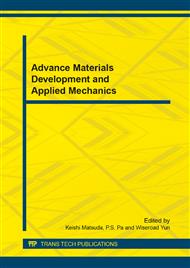[1]
S. Iijima. Helical microtubules of graphitic carbon, Nature, 354 (1991) 56-58.
DOI: 10.1038/354056a0
Google Scholar
[2]
Z. Liu, S. Tabakman, K. Welsher, et al. Carbon nanotubes in biology and medicine: in vitro and in vivo detection, imaging and drug delivery, Nano Res., 2 (2009) 85-120.
DOI: 10.1007/s12274-009-9009-8
Google Scholar
[3]
W. Yang, P. Thordarson, J.J. Gooding, et al. Carbon nanotubes for biological and biomedical applications, Nanotechnology, 41 (2007) 412001-1-8.
DOI: 10.1088/0957-4484/18/41/412001
Google Scholar
[4]
A.A. Kuznetzov, S.B. Lee, M. Zhang, et al. Electron field emission from transparent multiwalled carbon nanotube sheets for inverted field emission displays, Carbon, 48 (2010) 41-46.
DOI: 10.1016/j.carbon.2009.08.009
Google Scholar
[5]
I. Lahiri, R. Seelaboyina, J.Y. Hwang, et al. Enhanced field emission from multi-walled carbon nanotubes grown on pure copper substrate, Carbon, 48, (2010) 1531-1538.
DOI: 10.1016/j.carbon.2009.11.064
Google Scholar
[6]
M. Kaempgen, C.K. Chan, J. Ma, et al. Printable thin film supercapacitors using single-walled carbon nanotubes, Nano Lett., 9, (2009) 1872-1876.
DOI: 10.1021/nl8038579
Google Scholar
[7]
J. Yan, J. Liu, Z. Fan, et al. High-performance supercapacitor electrodes based on highly corrugated grapheme sheets, Carbon, 50 (2012) 2179-2188.
DOI: 10.1016/j.carbon.2012.01.028
Google Scholar
[8]
H. Jin, D.A. Heller, M. Kalbacova, et al. Detection of single-molecule H2O2 signalling from epidermal growth factor receptor using fluorescent single-walled carbon nanotubes, Nature Nanotechnology, 5, (2010) 302-309.
DOI: 10.1038/nnano.2010.24
Google Scholar
[9]
D.R. Kauffman, D.C. Sorescu, D.P. Schofield, et al. Understanding the sensor response of metal-decorated carbon nanotubes, Nano lett., 10, (2010) 958-963.
DOI: 10.1021/nl903888c
Google Scholar
[10]
M. Mazaheri, D. Mari, Z.R. Hesabi, et al. Multi-walled carbon nanotube/nanostructured zirconia composites: Outstanding mechanical properties in a wide range of temperature, Compos. Sci. Technol., 71, (2011) 939-945.
DOI: 10.1016/j.compscitech.2011.01.017
Google Scholar
[11]
M.K. Yeh, N.H. Tai and J.H. Liu. Mechanical behavior of phenolic-based composites reinforced with multi-walled carbon nanotubes, Carbon, 44 (2006) 1-9.
DOI: 10.1016/j.carbon.2005.07.005
Google Scholar
[12]
B.M. Wang, Y. Han and S. Liu. Effect of highly dispersed carbon nanotubes on the flexural toughness of cement-based composites, Constr. Build. Mater., 46 (2013) 8-12.
DOI: 10.1016/j.conbuildmat.2013.04.014
Google Scholar
[13]
G.Y. Li, P.M. Wang and X. Zhao. Mechanical behavior and microstructure of cement composites incorporating surface-treated multi-walled carbon nanotubes, Carbon, 43 (2005) 1239-1245.
DOI: 10.1016/j.carbon.2004.12.017
Google Scholar
[14]
S. Musso, J.M. Tulliani, G. Ferro, et al. Influence of carbon nanotubes structure on the mechanical behavior of cement composites, Compos Sci Technol, 69 (2009) 1985-(1990).
DOI: 10.1016/j.compscitech.2009.05.002
Google Scholar
[15]
B. Wang, Y. Han and T. Zhang. Morphological properties of surface-treated carbon nanotubes in cement-based composites, J. Nanosci. Nanotech., 12 (2012) 8415-8419.
DOI: 10.1166/jnn.2012.6635
Google Scholar
[16]
M Grujicic, G Cao and R Singh. A computational analysis of the percolation threshold and the electrical conductivity of carbon nanotubes filled polymeric materials, J. Mater. Sci., 39 (2004) 4441-4449.
DOI: 10.1023/b:jmsc.0000034136.11779.96
Google Scholar
[17]
C. Li, E.T. Thostenson, T.W. Chou. Sensors and actuators based on carbon nanotubes and their composites: A review, Compos., Sci., Technol., 68 (2008) 1227-1249.
DOI: 10.1016/j.compscitech.2008.01.006
Google Scholar
[18]
Y. Yu, G. Song and L. Sun. Determinant role of tunneling resistance in electrical conductivity of polymer composites reinforced by well dispersed carbon nanotubes, J. Appl. Phys., 108 (2010) 084319-1-5.
DOI: 10.1063/1.3499628
Google Scholar
[19]
Y. Yu, S. Song, Z. Bu, et al. Influence of filler waviness and aspect ratio on the percolation threshold of carbon nanomaterials reinforced polymer nanocomposites, J. Mater. Sci., 48 (2013) 5727-5732.
DOI: 10.1007/s10853-013-7364-z
Google Scholar
[20]
F. Dalmas, R. Dendievel, L. Chazeau, et al. Carbon nanotube-filled polymer composites. Numerical simulation of electrical conductivity in three-dimensional entangled fibrous networks, Acta Mater., 54 (2006) 2923-2931.
DOI: 10.1016/j.actamat.2006.02.028
Google Scholar
[21]
J. P. Vassal, L. Orgeas, and D. Favier. Modelling microstructure effects on the conduction in fibrous materials with fibre-fibre interface barriers, Modell. Simul, Mater. Sci. Eng., 3 (2008) 035007-1-19.
DOI: 10.1088/0965-0393/16/3/035007
Google Scholar
[22]
M. Foygel, R. D. Morris, D. Anez, et al. Theoretical and computational studies of carbon nanotube composites and suspensions: Electrical and thermal conductivity, Phys. Rev. B., 71 (2005) 104201-1-8.
DOI: 10.1103/physrevb.71.104201
Google Scholar


